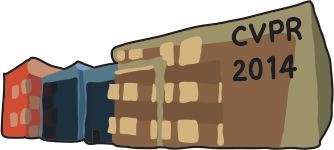-
Learning Optimal Seeds for Diffusion-based Salient Object Detection
AbstractIn diffusion-based saliency detection, an image is partitioned into superpixels and mapped to a graph, with superpixels as nodes and edge strengths proportional to superpixel similarity. Saliency information is then propagated over the graph using a diffusion process, whose equilibrium state yields the object saliency map. The optimal solution is the product of a propagation matrix and a saliency seed vector that contains a prior saliency assessment. This is obtained from either a bottom-up saliency detector or some heuristics. In this work, we propose a method to learn optimal seeds for object saliency. Two types of features are computed per superpixel: the bottom-up saliency of the superpixel region and a set of mid-level vision features informative of how likely the superpixel is to belong to an object. The combination of features that best discriminates between object and background saliency is then learned, using a large-margin formulation of the discriminant saliency principle. The propagation of the resulting saliency seeds, using a diffusion process, is finally shown to outperform the state of the art on a number of salient object detection datasets.
Related Material
[pdf][bibtex]@InProceedings{Lu_2014_CVPR,
author = {Lu, Song and Mahadevan, Vijay and Vasconcelos, Nuno},
title = {Learning Optimal Seeds for Diffusion-based Salient Object Detection},
booktitle = {Proceedings of the IEEE Conference on Computer Vision and Pattern Recognition (CVPR)},
month = {June},
year = {2014}
}
These CVPR 2014 papers are the Open Access versions, provided by the Computer Vision Foundation.
Except for the watermark, they are identical to the accepted versions; the final published version of the proceedings is available on IEEE Xplore.
Except for the watermark, they are identical to the accepted versions; the final published version of the proceedings is available on IEEE Xplore.
This material is presented to ensure timely dissemination of scholarly and technical work.
Copyright and all rights therein are retained by authors or by other copyright holders.
All persons copying this information are expected to adhere to the terms and constraints invoked by each author's copyright.

